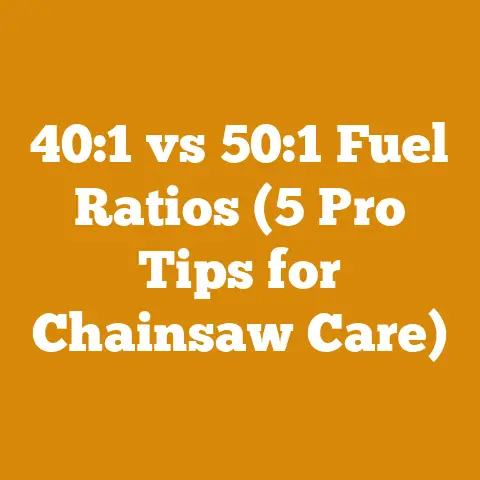Hydraulic Oil Transfer Pump 12V for Firewood Saws (5 Pro Tips)
Ever felt the frustration of a sluggish hydraulic system on your log splitter, especially when you’re knee-deep in a mountain of wood that needs to be prepped before winter? I certainly have. And that’s where a reliable hydraulic oil transfer pump comes in. Today, I want to share my experiences and insights on selecting and using a 12V hydraulic oil transfer pump, specifically tailored for firewood saws and log splitters. This isn’t just about pumps; it’s about maximizing efficiency, minimizing downtime, and ensuring the longevity of your equipment.
Hydraulic Oil Transfer Pump 12V for Firewood Saws: 5 Pro Tips
Hydraulic systems are the backbone of many wood processing tools, especially log splitters and some firewood saws. Maintaining the hydraulic fluid is crucial for their optimal operation. A 12V hydraulic oil transfer pump provides a convenient and efficient way to change, refill, or transfer hydraulic oil, minimizing downtime and preventing potential damage to your equipment.
Why a 12V Hydraulic Oil Transfer Pump?
Before diving into the pro tips, let’s understand why a 12V hydraulic oil transfer pump is a valuable asset for anyone involved in firewood preparation:
- Portability: 12V pumps can be easily powered by a vehicle battery or a portable power source, making them ideal for field use or remote locations.
- Efficiency: These pumps are designed to transfer oil quickly and cleanly, reducing the time and effort required for maintenance.
- Versatility: They can be used for various hydraulic systems, including log splitters, firewood processors, and even some chainsaws with hydraulic components.
- Cost-Effectiveness: Compared to manual pumps or professional servicing, a 12V pump offers a cost-effective solution for maintaining your hydraulic systems.
Pro Tip #1: Selecting the Right Pump
Choosing the right pump is the foundation of a smooth operation. Here’s what I consider crucial:
- Flow Rate: The flow rate, measured in gallons per minute (GPM) or liters per minute (LPM), determines how quickly the pump can transfer oil. For most log splitters, a flow rate of 2-4 GPM is sufficient. Larger firewood processors might benefit from a pump with a higher flow rate.
- Example: My old log splitter, a 27-ton model, works perfectly with a 2.5 GPM pump. I can completely change the hydraulic oil in about 20 minutes.
- Pressure Rating: Ensure the pump’s pressure rating is compatible with your hydraulic system’s requirements. Exceeding the pressure rating can damage the pump, while insufficient pressure can lead to slow or inefficient transfer.
- Data Point: Most log splitters operate at pressures between 2000 and 3000 PSI. A pump with a pressure rating slightly above this range provides a safety margin.
- Fluid Compatibility: Verify that the pump is compatible with the type of hydraulic oil you use. Some pumps are designed for specific types of oil, while others are more versatile. Using the wrong type of oil can damage the pump’s seals and internal components.
- Personal Experience: I once used a pump that wasn’t compatible with synthetic hydraulic oil. The seals deteriorated within a few weeks, leading to a messy and costly repair.
- Build Quality: Look for pumps made from durable materials, such as cast iron or aluminum, with robust construction. The pump should be able to withstand the rigors of field use and frequent operation.
- Tip: Check customer reviews and ratings to get an idea of the pump’s reliability and longevity.
- Port Size and Fittings: Ensure the pump has the correct port size and fittings for your hydraulic system. This will prevent leaks and ensure a secure connection.
- Measurement: Standard hydraulic fittings are often NPT (National Pipe Thread) sizes. Measure the port size on your equipment and match it to the pump’s fittings.
Pro Tip #2: Preparing Your Work Area
A clean and organized work area is essential for any hydraulic oil transfer. Here’s how I prepare:
- Safety First: Wear safety glasses, gloves, and appropriate clothing to protect yourself from spills and splashes. Hydraulic oil can be harmful to the skin and eyes.
- Safety Standard: Always refer to the Material Safety Data Sheet (MSDS) for the specific hydraulic oil you are using.
- Surface Protection: Place a drip pan or absorbent mat under the hydraulic system to catch any spills. This will prevent oil from contaminating the surrounding area and making cleanup easier.
- Case Study: I once forgot to use a drip pan and ended up with a large oil stain on my concrete driveway. It took hours to clean up and required special degreasers.
- Ventilation: Ensure adequate ventilation to prevent the buildup of fumes. Hydraulic oil can release harmful vapors when heated.
- Recommendation: Work outdoors or in a well-ventilated area. If working indoors, use a fan to circulate the air.
- Tool Organization: Gather all the necessary tools and equipment, including wrenches, screwdrivers, funnels, and containers for used oil. This will streamline the transfer process and prevent delays.
- Tool List: I always keep a set of adjustable wrenches, a funnel with a filter, and several empty 5-gallon buckets on hand.
- Equipment Preparation: Allow the hydraulic system to cool down before starting the transfer. Hot oil can be dangerous and may damage the pump.
- Timing Estimate: Let the equipment cool down for at least 30 minutes after use.
Pro Tip #3: The Transfer Process – Step by Step
Here’s a detailed guide on how I perform the hydraulic oil transfer:
- Disconnect the Power: Before starting any maintenance, disconnect the power source to the hydraulic system. This will prevent accidental activation of the equipment.
- Warning: Always disconnect the spark plug wire on gasoline-powered log splitters or unplug electric models.
- Locate the Drain Plug: Identify the drain plug on the hydraulic reservoir. It is usually located at the bottom of the reservoir.
- Tip: Refer to the equipment’s manual for the exact location of the drain plug.
- Position the Container: Place a container under the drain plug to catch the used oil. Make sure the container is large enough to hold the entire contents of the reservoir.
- Measurement: Most log splitters have a hydraulic reservoir capacity of 5-10 gallons.
- Remove the Drain Plug: Carefully remove the drain plug using a wrench. Allow the oil to drain completely into the container.
- Caution: Be prepared for a sudden rush of oil when the drain plug is removed.
- Inspect the Drain Plug: Check the drain plug for any signs of damage or wear. Replace it if necessary.
- Maintenance Tip: Clean the drain plug and apply Teflon tape to the threads before reinstalling it.
- Connect the Pump: Connect the 12V hydraulic oil transfer pump to the hydraulic system. Attach one hose to the reservoir’s fill port and the other hose to the container of new hydraulic oil.
- Fitting Tip: Use appropriate fittings and adapters to ensure a secure and leak-free connection.
- Power the Pump: Connect the pump to a 12V power source, such as a vehicle battery or a portable power pack.
- Safety Note: Ensure the power source is properly grounded and that the pump is protected by a fuse.
- Start the Transfer: Turn on the pump and allow it to transfer the new hydraulic oil into the reservoir. Monitor the oil level in the reservoir to prevent overfilling.
- Observation: Watch for any leaks or unusual noises during the transfer process.
- Check the Oil Level: Once the reservoir is full, turn off the pump and disconnect it from the power source. Check the oil level using the dipstick or sight glass.
- Specification: The oil level should be within the recommended range, as specified in the equipment’s manual.
- Reinstall the Drain Plug: Reinstall the drain plug and tighten it securely.
- Torque Specification: Refer to the equipment’s manual for the recommended torque specification.
- Clean Up: Clean up any spills and dispose of the used oil properly.
- Environmental Responsibility: Take the used oil to a recycling center or a designated collection point.
Pro Tip #4: Optimizing Pump Performance
To get the most out of your 12V hydraulic oil transfer pump, consider these optimization tips:
- Proper Priming: Before starting the pump, make sure it is properly primed. This means filling the pump with hydraulic oil to prevent air from entering the system.
- Priming Method: Pour a small amount of hydraulic oil into the pump’s inlet port before connecting the hoses.
- Hose Length and Diameter: Use hoses of appropriate length and diameter to minimize pressure drop and maximize flow rate. Long or narrow hoses can restrict the flow of oil.
- Measurement: I recommend using hoses with a minimum diameter of 1/2 inch and keeping the length under 10 feet.
- Filter Maintenance: Regularly clean or replace the pump’s filter to prevent contaminants from entering the hydraulic system. A clogged filter can reduce the pump’s efficiency and damage its internal components.
- Maintenance Schedule: Check the filter every 50 hours of operation and replace it as needed.
- Voltage Stability: Ensure a stable voltage supply to the pump. Fluctuations in voltage can affect the pump’s performance and lifespan.
- Power Source Recommendation: Use a battery charger or a voltage regulator to maintain a consistent voltage supply.
- Temperature Control: Avoid operating the pump in extreme temperatures. High temperatures can reduce the oil’s viscosity and affect the pump’s performance, while low temperatures can make the oil too thick to pump efficiently.
- Operating Range: The ideal operating temperature for most hydraulic oil transfer pumps is between 50°F and 100°F.
Pro Tip #5: Troubleshooting Common Issues
Even with proper care and maintenance, you may encounter some common issues with your 12V hydraulic oil transfer pump. Here’s how I troubleshoot them:
- Pump Not Pumping:
- Cause: Air in the system, clogged filter, or faulty pump motor.
- Solution: Prime the pump, clean or replace the filter, and check the pump motor for any signs of damage.
- Slow Pumping:
- Cause: Low voltage, restricted hoses, or worn pump components.
- Solution: Check the voltage supply, inspect the hoses for kinks or obstructions, and replace any worn pump components.
- Pump Leaking:
- Cause: Damaged seals, loose fittings, or cracked pump housing.
- Solution: Replace the seals, tighten the fittings, and repair or replace the pump housing.
- Pump Overheating:
- Cause: Overload, insufficient ventilation, or faulty pump motor.
- Solution: Reduce the load on the pump, improve ventilation, and check the pump motor for any signs of damage.
- Unusual Noises:
- Cause: Cavitation, worn bearings, or foreign objects in the pump.
- Solution: Prime the pump, replace the bearings, and remove any foreign objects from the pump.
Case Study: Reviving an Old Log Splitter
I once inherited an old log splitter that had been sitting unused for several years. The hydraulic system was sluggish and unresponsive. After inspecting the system, I found that the hydraulic oil was contaminated and the pump was not functioning properly.
I started by draining the old oil and flushing the system with a cleaning solvent. Then, I replaced the hydraulic oil filter and installed a new 12V hydraulic oil transfer pump. After priming the pump and connecting it to the hydraulic system, I turned it on and allowed it to circulate the new oil.
To my surprise, the log splitter came back to life. The hydraulic system was now responsive and powerful, and the splitter was able to handle even the toughest logs. This experience taught me the importance of proper hydraulic system maintenance and the value of a reliable hydraulic oil transfer pump.
Wood Type Considerations
The type of wood you’re processing also plays a role in hydraulic system performance. Hardwoods like oak, maple, and hickory require more force to split than softwoods like pine and fir. This increased demand can put a strain on the hydraulic system, making proper maintenance even more critical.
- Oak: Known for its density and strength, oak requires a log splitter with sufficient tonnage and a well-maintained hydraulic system.
- Maple: Similar to oak, maple can be challenging to split, especially when it’s knotty or twisted.
- Pine: Easier to split than hardwoods, pine still benefits from a properly maintained hydraulic system, especially when processing large volumes.
Chainsaw Considerations
While this article focuses on log splitters, some firewood saws also utilize hydraulic systems. These saws typically use hydraulic power to advance the log through the cutting blade. Maintaining the hydraulic system on these saws is just as important as it is on log splitters.
- Hydraulic Chainsaws: These chainsaws use hydraulic power to drive the cutting chain, offering high power and efficiency. They are often used in professional logging operations.
- Firewood Processors: These machines combine sawing and splitting functions, often using hydraulic power to automate the process.
Drying Methods
Properly seasoned firewood burns more efficiently and produces less smoke. The moisture content of firewood should be below 20% for optimal burning. Here are some common drying methods:
- Air Drying: The most common method, air drying involves stacking firewood in a well-ventilated area and allowing it to dry naturally.
- Timing Estimate: Air drying typically takes 6-12 months, depending on the climate and wood type.
- Kiln Drying: A faster method, kiln drying involves placing firewood in a kiln and using heat to remove moisture.
- Timing Estimate: Kiln drying can reduce the moisture content to below 20% in a matter of days.
- Solar Drying: Using solar energy to dry firewood, this method is environmentally friendly and cost-effective.
- Timing Estimate: Solar drying can take several weeks to months, depending on the weather conditions.
Stacking Techniques
Proper firewood stacking is essential for efficient drying and storage. Here are some common stacking techniques:
- Crisscross Stacking: This method involves stacking the firewood in a crisscross pattern, creating air gaps for ventilation.
- Holz Hausen: A traditional German method, the Holz Hausen involves stacking firewood in a circular pile with a hollow center for ventilation.
- Linear Stacking: The simplest method, linear stacking involves stacking firewood in straight rows, leaving space between the rows for ventilation.
Strategic Advantages
Investing in a 12V hydraulic oil transfer pump offers several strategic advantages:
- Reduced Downtime: By performing hydraulic system maintenance yourself, you can minimize downtime and keep your equipment running smoothly.
- Cost Savings: Regular maintenance can prevent costly repairs and extend the lifespan of your equipment.
- Increased Efficiency: A well-maintained hydraulic system operates more efficiently, allowing you to process more firewood in less time.
- Improved Safety: Proper maintenance can prevent hydraulic system failures, reducing the risk of accidents and injuries.
Relevant Technical Details
Here are some relevant technical details to consider when selecting and using a 12V hydraulic oil transfer pump:
- Limited Access to Tools and Equipment: In some regions, access to tools and equipment like log splitters and hydraulic oil transfer pumps may be limited.
- Lack of Technical Knowledge: Some DIYers may lack the technical knowledge needed to properly maintain hydraulic systems.
- Environmental Regulations: Environmental regulations regarding firewood harvesting and burning may vary from region to region.
- Climate Conditions: Climate conditions can affect the drying time of firewood and the performance of hydraulic systems.
Next Steps
Now that you have a better understanding of 12V hydraulic oil transfer pumps and their role in firewood preparation, here are some practical next steps:
- Assess Your Needs: Determine the flow rate, pressure rating, and fluid compatibility requirements for your hydraulic system.
- Research and Compare Pumps: Research different 12V hydraulic oil transfer pumps and compare their features, specifications, and prices.
- Purchase a Pump: Purchase a pump that meets your needs and budget.
- Gather Your Tools and Equipment: Gather all the necessary tools and equipment for performing hydraulic system maintenance.
- Follow the Steps: Follow the step-by-step guide outlined in this article to perform hydraulic oil transfers and troubleshoot common issues.
- Implement Proper Maintenance: Implement a regular maintenance schedule to keep your hydraulic system running smoothly and efficiently.
- Stay Informed: Stay informed about the latest tools, techniques, and safety standards related to logging and firewood production.
By following these pro tips and taking the necessary steps, you can maximize the efficiency, minimize downtime, and ensure the longevity of your hydraulic equipment. Remember, proper maintenance is the key to a smooth and productive firewood preparation process. And, who knows, maybe you’ll even enjoy the process a little more knowing your equipment is in top shape!






